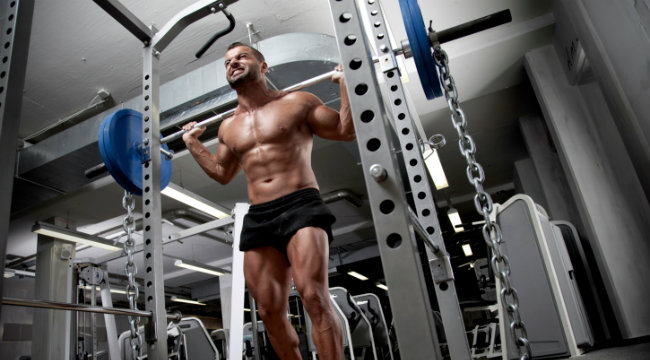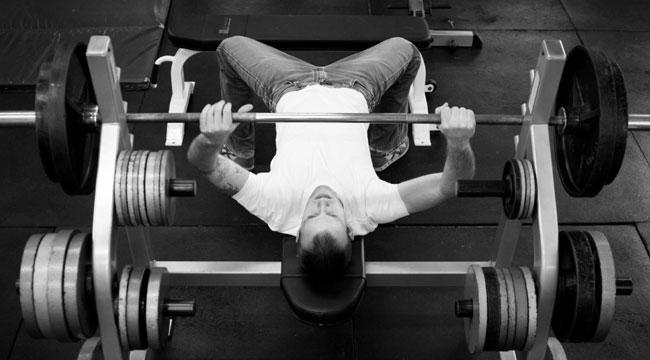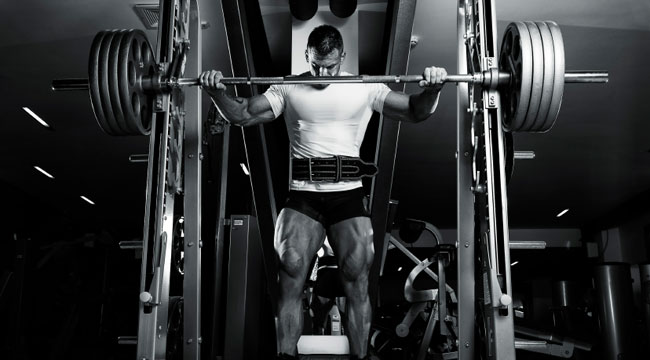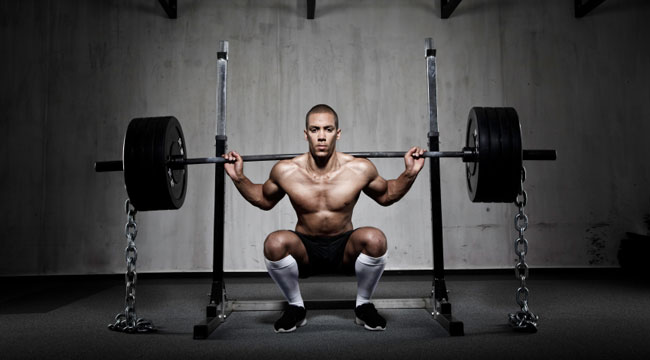28-Days-to-Lean Meal Plan
With the right plan and the right discipline, you can get seriously shredded in just 28 days.
Read article
Weight belts, chalk, straps and truckloads of iron. For decades, these items have served as the base equipment for building not only mounds of muscle but also raw, bar-bending strength. Over the years, these primitive implements have helped push the limits of the human physique, making it possible to win the battle against gravity day in and day out. But their most important contribution may be to one of the most basic mandates of weight-lifting: progressive overload.
The principle of progressive overload simply states that an increase in volume and intensity is required to achieve a targeted goal. Weight begets weight, and each workout is a step toward your objective. Bench-pressing 405 pounds one time, for example, requires a lifter to work his way up from his starting one-rep max with incrementally heavier loads until he reaches that 405-pound benchmark. How long it takes to reach a given goal is, of course, unique to each lifter. It could conceivably take one person years to hit that standard, while another may land in the coveted four-plates-per-side promised land after only months of training.
What about achieving progressive overload with each rep? Imagine the benefits you could reap from repetitions that get harder and heavier with each inch the weight is moved – challenging reps that offer no rest for muscles accustomed to recovering during lockouts or benefiting from elasticity. Weight belts, chalk, straps and truckloads of iron – they build muscle, all right. But to these things we now add chains and bands.
The secret to both chains and bands is that they provide what’s known as linear variable resistance. Linear variable resistance training (LVRT) refers to progressively increasing the resistance with the range of motion. Using the bench press as an example, the resistance gets progressively heavier the farther you press the bar toward full arm extension. The increased resistance necessitates the application of more force toward the top of the lift.
So what’s the benefit to you? More muscle, that’s what. As the range of motion lengthens and the resistance increases, the number of muscle fibers being used in the exercising muscle increases as well. The more muscle fibers being used, the greater the adaptations in muscle strength that can be achieved.
Bands also boost force during the negative part of a rep because they increase its speed. This means you have to apply more force to stop the weight at the bottom ofthe rep. Again, the more force you have to apply, the greater the sum of muscle fibers that are called into action.
Need more convincing? One study performed at Truman State University (Kirksville, Missouri) found that athletes who included elastic-resistance bench-press training in their regimens had a significantly greater increase in bench-press strength and power compared to those who utilized only free-weight resistance.
Another study, performed at the University of Wisconsin, La Crosse, reported in a 2006 issue of The Journal of Strength and Conditioning Research that when athletes used elastic-band training in addition to free-weight training, they had significantly more leg power than when they performed only free-weight training.
Research shows that when comparing the same exercise performed with elastic bands vs. free weights, the amount of muscle fibers activated and the amount of force provided by the muscle fibers is similar. Studies also show that programs using elastic tubing, elastic bands and similar devices by themselves increase muscle strength and size and decrease bodyfat in a manner similar to free-weight training.

As you’ve probably gathered by now, most of the research done on LVRT has used elastic-band equipment, a rehabilitative device and fitness tool for almost a century. Chains, on the other hand, are new implements in the weight room, and they provide similar benefits to bands. The major difference is in how they work.
Chains provide resistance through the weight of each link. As they hang off the bar and pool on the floor, the only extra weight they provide is from the links between the bar and the floor. As you lift the bar higher, more links come off the floor and add weight to the bar. Elastic bands, on the other hand, provide resistance by a restoring force, which attempts to move the two ends of each band back to their original resting positions when they’re pulled farther apart. The more you pull the bands (such as at the top of the range of motion of a squat), the greater the resistance.
We’re not telling you to use LVRT in place of free weights; we’re telling you to consider using chains and bands with free weights. By increasing the amount of force it takes to move a weight from point A to point B, chains and bands can build denser, stronger muscle. And what bodybuilder wouldn’t want that?
No partner to help you test your 1RM? Finding your 5RM is just as good Just in case you’re afraid of getting a bar pinned across your neck on a one-rep max (1RM) test, we’ve got a pretty reliable alternative. Research shows that using a five-rep max (5RM) to determine your 1RM is about 99% accurate for upper-body exercises and 97% accurate for lower-body exercises. That’s close enough. Not to mention, it’s more important for bodybuilders to be strong with a weight they can lift for several reps than for just one – you don’t get bigger by doing singles.
To calculate your 1RM for an exercise, find a weight that permits you to get five, and only five, reps; you shouldn’t be able to get a sixth rep on your own. Take each weight and use one of these equations to determine your 1RM for the particular exercise.
(5RM weight x 1.1307) + 0.6998 = 1RM
Example: If you bench 300 pounds for five reps, your 1RM would be (300 x 1.1307) + 0.6998 = 340 pounds.
(5RM weight x 1.09703) + 14.2546 = 1RM
Example: If you squat 400 pounds for five reps, your 1RM would be (400 x 1.09703) + 14.2546 = 453 pounds, or 455 pounds (rounded up)

How you set up bands depends on the equipment you have available in your gym. Do your squats in a power rack. You can loop the bands around the bottom of the rack or place the safety bars in the lowest position and loop the bands around them. Wrap the other end around the end of the bar. The bench press may also need to be performed in a power rack with the bands set up as suggested for the squat, or you can loop the bands around very heavy dumbbells. Regardless of how you set up your bands, be sure you do so properly and evenly. If not, one side may have more tension than the other and cause the bar to be uneven. See the photos that follow for examples.
You’ll need to know your one-rep max (1RM) to determine the amount of free-weight and band resistance to put on the bar. Do a true 1RM test under partner supervision or estimate it by using our 1RM formula (see “One-Rep Max Calculator”).
To determine the resistance supplied by unmarked bands, stand on a scale holding an empty bar in the top position of a squat with the bands set up. Be sure to deduct your bodyweight and the weight of the bar (most Olympic bars are 45 pounds). If you get the M&F Strength Bands from StrengthBands.com, it supplies several different bands with the amounts of resistance specified. Find the one that supplies the amount of resistance needed. In some cases, you may need to use more than one band to obtain the right resistance.
Aim to generate maximum force on the positive rep.
| Exercise | Weight | Sets/Reps |
| Bench Press | Band = 10% 1RM Free weight = 20% 1RM Total = 30% 1RM |
3/3-5 |
| Bench Press | Free weight = 70% 1RM | 3/8-10 |
| Incline Bench Press | – | 3/10-12 |
| Dumbbell Flye | – | 3/10-12 |
| Exercise | Weight | Sets/Reps |
| Bench Press | Band = 15% 1RM Free weight = 25% 1RM Total = 40% 1RM |
3/3-5 |
| Bench Press | Free weight = 75% 1RM | 3/8 |
| Incline Bench Press | – | 3/10 |
| Dumbbell Flye | – | 3/10 |
| Exercise | Weight | Sets/Reps |
| Bench Press | Band = 15% 1RM Free weight = 35% 1RM Total = 50% 1RM |
3/3-5 |
| Bench Press | Free weight = 80% 1RM | 3/6-8 |
| Incline Bench Press | – | 3/8-10 |
| Dumbbell Flye | – | 3/8-10 |
| Exercise | Weight | Sets/Reps |
| Bench Press | Band = 20% 1RM Free weight = 40% 1RM Total = 60% 1RM |
3/3-5 |
| Bench Press | Free weight = 85% 1RM | 3/4-6 |
| Incline Bench Press | – | 3/8 |
| Dumbbell Flye | – | 3/8 |
| Exercise | Weight | Sets/Reps |
| Bench Press | Band = 20% 1RM Free weight = 50% 1RM Total = 70% 1RM |
3/3-5 |
| Bench Press | Free weight = 90% 1RM | 3/2-4 |
| Incline Bench Press | – | 3/6-8 |
| Dumbbell Flye | – | 3/6-8 |
| Exercise | Weight | Sets/Reps |
| Bench Press | Band = 20% 1RM Free weight = 60% 1RM Total = 80% 1RM |
3/3-5 |
| Bench Press | Free weight = 95% 1RM | 3/1-2 |
| Incline Bench Press | – | 3/6 |
| Dumbbell Flye | – | 3/6-8 |

Set the bands in such a way that taking the bar off the rack doesn’t pull you forward or back or make the movement awkward. After a careful descent, explode upward to counter the additional resistance of the bands.
| Exercise | Weight | Sets/Reps |
| Squat | Band = 10% 1RM Free weight = 20% 1RM Total = 30% 1RM |
3/3-5 |
| Squat | Free weight = 70% 1RM | 3/8-10 |
| Leg Press | – | 3/10-12 |
| Leg Extension | – | 3/10-12 |
| Romanian Deadlift | – | 3/10-12 |
| Exercise | Weight | Sets/Reps |
| Squat | Band = 15% 1RM Free weight = 25% 1RM Total = 40% 1RM |
3/3-5 |
| Squat | Free weight = 75% 1RM | 3/8 |
| Leg Press | – | 3/10-12 |
| Leg Extension | – | 3/10-12 |
| Romanian Deadlift | – | 3/10-12 |
| Exercise | Weight | Sets/Reps |
| Squat | Band = 15% 1RM Free weight = 35% 1RM Total = 50% 1RM |
3/3-5 |
| Squat | Free weight = 80% 1RM | 3/6-8 |
| Leg Press | – | 3/8-10 |
| Leg Extension | – | 3/8-10 |
| Romanian Deadlift | – | 3/8-10 |
| Exercise | Weight | Sets/Reps |
| Squat | Band = 20% 1RM Free weight = 40% 1RM Total = 60% 1RM |
3/3-5 |
| Squat | Free weight = 85% 1RM | 3/4-6 |
| Leg Press | – | 3/8 |
| Leg Extension | – | 3/8 |
| Romanian Deadlift | – | 3/8 |
| Exercise | Weight | Sets/Reps |
| Squat | Band = 20% 1RM Free weight = 50% 1RM Total = 70% 1RM |
3/3-5 |
| Squat | Free weight = 90% 1RM | 3/2-4 |
| Leg Press | – | 3/6-8 |
| Leg Extension | – | 3/6-8 |
| Romanian Deadlift | – | 3/6-8 |
| Exercise | Weight | Sets/Reps |
| Squat | Band = 20% 1RM Free weight = 60% 1RM Total = 80% 1RM |
3/3-5 |
| Squat | Free weight = 95% 1RM | 3/1-2 |
| Leg Press | – | 3/6 |
| Leg Extension | – | 3/6 |
| Romanian Deadlift | – | 3/6 |

Setting up chains is a bit simpler than bands, but carrying the extra weight with you to the gym can be a clangy, awkward mess. But hey, if that’s all you have to bear to add some new bulk, so be it. If you order the complete set of chains from elitefts, you’ll get two 3⁄8″ chains and two 5⁄8″ chains. The 3⁄8″ chain is used to wrap around the end of the bar and hold the 5⁄8″ chain. One 3⁄8″ chain (5 pounds) plus one 5⁄8″ chain (20 pounds) weighs about 25 pounds. You may have to use additional chain weight depending on your strength.
When setting up the chains on the bar, it’s crucial that the 5⁄8″ chains rest completely on the floor in the bottom position. For the squat, consider setting up the chains so that a few links still rest on the floor in the top position. This will prevent the chains from swinging, especially when you walk the bar out of the rack. For the bench press, only about half of the links will be off the floor in the top position due to the short range of motion. That means if you have one set each of 3⁄8″ chains and 5⁄8″ chains on the bar, you’ll be using an additional 30 pounds of chain weight, not 50 pounds.
Use these recommended chain weights based on your 1RM
| 1RM Bench Press | Suggested Chain Weight |
| < 200 pounds | 20-30 pounds |
| 200-400 pounds | 40-50 pounds |
| 400-500 pounds | 80-90 pounds |
| 1RM Squat | Suggested Chain Weight |
| < 200 pounds | 40-50 pounds |
| 200-400 pounds | 50-60 pounds |
| 400-500 pounds | 60-70 pounds |
| 500-600 pounds | 80-90 pounds |
Your 1RM on the bench press will determine what your chain weight and starting free weight will be. With each inch you move the bar upward, you pick up additional links, which increases the resistance and recruits more muscle fibers.
For chain weight, see “Off the Chain” to determine how much resistance to use. Remember, on bench presses you’re using only half the weight of each 5⁄8″ chain.
| Exercise | Weight | Sets/Reps |
| Bench Press | Chain = TBD Free weight = 40% 1RM |
3/7-8 |
| Bench Press | Free weight = 60% 1RM | 3/12-15 |
| Incline Dumbbell Press | – | 3/10-12 |
| Dumbbell Flye | – | 3/10-12 |
| Exercise | Weight | Sets/Reps |
| Bench Press | Chain = TBD Free weight = 50% 1RM |
3/6-7 |
| Bench Press | Free weight = 6=50% 1RM | 3/10-12 |
| Incline Dumbbell Press | – | 3/10 |
| Dumbbell Flye | – | 3/10 3/10 |
| Exercise | Weight | Sets/Reps |
| Bench Press | Chain = TBD Free weight = 55% 1RM |
3/5-6 |
| Bench Press | Free weight = 75% 1RM | 3/8-10 |
| Incline Dumbbell Press | – | 3/8-10 |
| Dumbbell Flye | – | 3/8-10 |
| Exercise | Weight | Sets/Reps |
| Bench Press | Chain = TBD Free weight = 60% 1RM |
3/4-5 |
| Bench Press | Free weight = 80% 1RM | 3/6-8 |
| Incline Dumbbell Press | – | 3/8 |
| Dumbbell Flye | – | 3/8 |
| Exercise | Weight | Sets/Reps |
| Bench Press | Chain = TBD Free weight = 65% 1RM |
3/3-4 |
| Bench Press | Free weight = 85% 1RM | 3/4-6 |
| Incline Dumbbell Press | – | 3/6-8 |
| Dumbbell Flye | – | 3/6-8 |
| Exercise | Weight | Sets/Reps |
| Bench Press | Chain = TBD Free weight = 70% 1RM |
3/3 |
| Bench Press | Free weight = 90% 1RM | 3/2-4 |
| Incline Dumbbell Press | – | 3/4-6 |
| Dumbbell Flye | – | 3/6 |

As with the bench press, your 1RM squat will dictate what your chain weight and free weight should be. Take advantage of the extra resistance by moving into the bottom position slowly before exploding up and getting full extension of your hips at the top. As usual, be careful not to lock out your knees.
For chain weight, see “Off the Chain” to determine how much resistance to use. Remember, 3⁄8″ chains weigh 5 pounds each; 5⁄8″ chains weigh 20 pounds.
| Exercise | Weight | Sets/Reps |
| Squat | Chain = TBD Free weight = 40% 1RM |
3/7-8 |
| Squat | Free weight = 60% 1RM | 3/12-15 |
| Smith Machine Front Squat | – | 3/10-12 |
| Leg Extension | – | 3/10-12 |
| Leg Curl | – | 3/10-12 |
| Exercise | Weight | Sets/Reps |
| Squat | Chain = TBD Free weight = 50% 1RM |
3/6-7 |
| Squat | Free weight = 70% 1RM | 3/10-12 |
| Smith Machine Front Squat | – | 3/10 |
| Leg Extension | – | 3/10 |
| Leg Curl | – | 3/10-12 |
| Exercise | Weight | Sets/Reps |
| Squat | Chain = TBD Free weight = 55% 1RM |
3/5-6 |
| Squat | Free weight = 75% 1RM | 3/8-10 |
| Smith Machine Front Squat | – | 3/8-10 |
| Leg Extension | – | 3/8-10 |
| Leg Curl | – | 3/8-10 |
| Exercise | Weight | Sets/Reps |
| Squat | Chain = TBD Free weight = 60% 1RM |
3/4-5 |
| Squat | Free weight = 80% 1RM | 3/6-8 |
| Smith Machine Front Squat | – | 3/8 |
| Leg Extension | – | 3/8 |
| Leg Curl | – | 3/8-10 |
| Exercise | Weight | Sets/Reps |
| Squat | Chain = TBD Free weight = 65% 1RM |
3/3-4 |
| Squat | Free weight = 85% 1RM | 3/4-6 |
| Smith Machine Front Squat | – | 3/6-8 |
| Leg Extension | – | 3/6-8 |
| Leg Curl | – | 3/5-8 |
| Exercise | Weight | Sets/Reps |
| Squat | Chain = TBD Free weight = 70% 1RM |
3/3 |
| Squat | Free weight = 90% 1RM | 3/2-4 |
| Smith Machine Front Squat | – | 3/4-6 |
| Leg Extension | – | 3/6 |
| Leg Curl | – | 3/6 |
Notifications